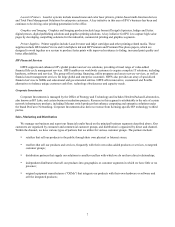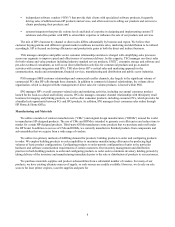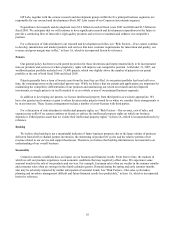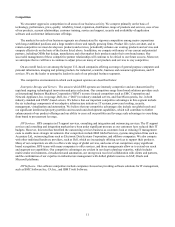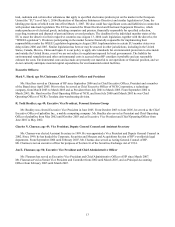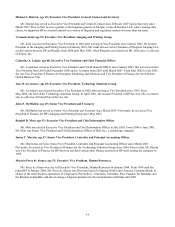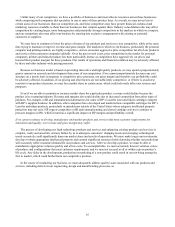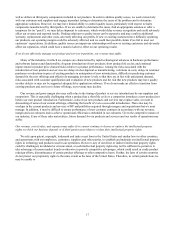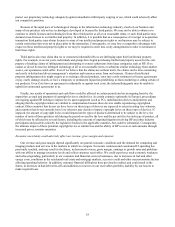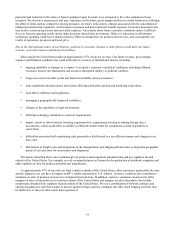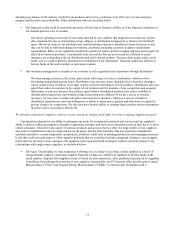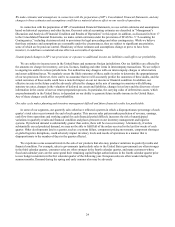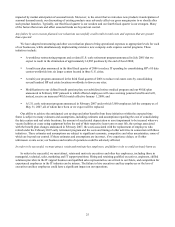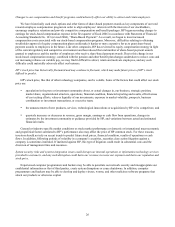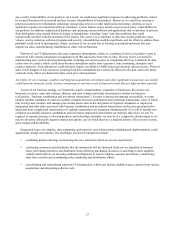HP 2007 Annual Report Download - page 31
Download and view the complete annual report
Please find page 31 of the 2007 HP annual report below. You can navigate through the pages in the report by either clicking on the pages listed below, or by using the keyword search tool below to find specific information within the annual report.well as defects in third-party components included in our products. In order to address quality issues, we work extensively
with our customers and suppliers and engage in product testing to determine the cause of the problem and to determine
appropriate solutions. However, we may have limited ability to control quality issues, particularly with respect to faulty
components manufactured by third parties. If we are unable to determine the cause, find an appropriate solution or offer a
temporary fix (or “patch”), we may delay shipment to customers, which would delay revenue recognition and could adversely
affect our revenue and reported results. Finding solutions to quality issues can be expensive and may result in additional
warranty, replacement and other costs, adversely affecting our profits. If new or existing customers have difficulty operating
our products, our operating margins could be adversely affected, and we could face possible claims if we fail to meet our
customers’ expectations. In addition, quality issues can impair our relationships with new or existing customers and adversely
affect our reputation, which could have a material adverse effect on our operating results.
If we do not effectively manage our product and services transitions, our revenue may suffer.
Many of the industries in which we compete are characterized by rapid technological advances in hardware performance
and software features and functionality; frequent introduction of new products; short product life cycles; and continual
improvement in product price characteristics relative to product performance. Among the risks associated with the
introduction of new products and services are delays in development or manufacturing, variations in costs, delays in customer
purchases or reductions in price of existing products in anticipation of new introductions, difficulty in predicting customer
demand for the new offerings and effectively managing inventory levels so that they are in line with anticipated demand,
risks associated with customer qualification and evaluation of new products and the risk that new products may have quality
or other defects or may not be supported adequately by application software. If we do not make an effective transition from
existing products and services to future offerings, our revenue may decline.
Our revenue and gross margin also may suffer due to the timing of product or service introductions by our suppliers and
competitors. This is especially challenging when a product has a short life cycle or a competitor introduces a new product just
before our own product introduction. Furthermore, sales of our new products and services may replace sales, or result in
discounting of some of our current offerings, offsetting the benefit of even a successful introduction. There also may be
overlaps in the current products and services of HP and portfolios acquired through mergers and acquisitions that we must
manage. In addition, it may be difficult to ensure performance of new customer contracts in accordance with our revenue,
margin and cost estimates and to achieve operational efficiencies embedded in our estimates. Given the competitive nature of
our industry, if any of these risks materializes, future demand for our products and services and our results of operations may
suffer.
Our revenue, cost of sales, and expenses may suffer if we cannot continue to license or enforce the intellectual property
rights on which our business depends or if third parties assert that we violate their intellectual property rights.
We rely upon patent, copyright, trademark and trade secret laws in the United States and similar laws in other countries,
and agreements with our employees, customers, suppliers and other parties, to establish and maintain our intellectual property
rights in technology and products used in our operations. However, any of our direct or indirect intellectual property rights
could be challenged, invalidated or circumvented, or such intellectual property rights may not be sufficient to permit us to
take advantage of current market trends or otherwise to provide competitive advantages, which could result in costly product
redesign efforts, discontinuance of certain product offerings or other competitive harm. Further, the laws of certain countries
do not protect our proprietary rights to the same extent as the laws of the United States. Therefore, in certain jurisdictions we
may be unable to
17


